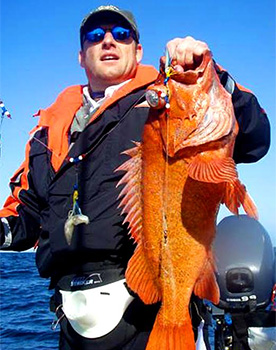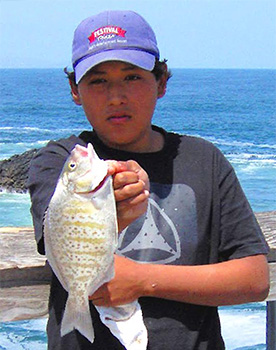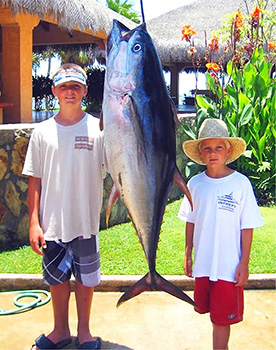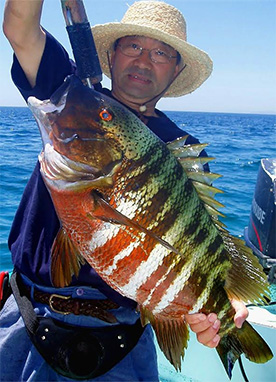 |  |
By Tom Gatch

This used to be the season when southern California anglers would get out the heavy duty rockcod gear, spool up their 6/0 to 9/0 reels with 80 to100 pound test Dacron line, and then start making plans to head out to the various offshore banks along our continental shelf to fill their freezers with the delicately flavored fillets of popular deep water species such as lingcod, salmon grouper and cow cod.
Over the past couple of decades, however, numerous laws have been enacted by both state and federal agencies that severely restrict this type of fishing during the very winter months when it once enjoyed peak popularity. Luckily, anglers still have access to the productive and much less restrictive waters of Baja California, which generously help to satisfy the winter needs of south coast ‘rock-codders’ who are frustrated by their inability to legally fish their own, local banks north of the border.
Baja’s northern Pacific coast between the border and Punta Baja features a nearly endless supply of deep canyons, ridges and jagged, offshore pinnacles that continue to harbor large congregations of rockfish, many of which are members of the Sebastes family. In relatively shallow depths of less than 200 feet, these fish respond well to standard dropper loop rigs with 4 to 8 ounces of lead at the terminal end. Two hooks should be positioned up the line on short leaders, a distance of 12 to 16 inches from each other. It is not unusual for a good spot to yield several species on any given day. Smaller fish such as vermilion, blue, canary and starry rockfish will readily take anchovies and sardines; but it is often advisable to use a tough, difficult to steal baits such as squid or cut mackerel.

This is also the time of year when turbulent winter storms between Playas de Tijuana and Bahia San Quintin batter the beaches, and simultaneously create prime fishing conditions for catching large, barred surfperch. Although there can certainly be decent action for this species along the southern California coast, many of northern Baja’s unpopulated beaches consistently prove to be far more productive. It is not uncommon to catch surfperch between 2 to 3 pounds in some of these locations.
The barred surfperch, Amphistichus argenteus, occurs from Plaza Maria Bay in Baja, to Bodega Bay in northern California. They are usually found in the surf zone along sandy beaches where they seem to congregate in depressions on the bottom. The most popular bait for barred surfperch is soft-shelled sand crabs, but fresh local mussels, cut bait, and small, plastic grubs in motor oil or red flake also work well. Perch fishing is usually best on an incoming tide when they tend to feed inside the breaker zone.
Further south, Bahia Asuncion offers a very good venue for surf fishing, as well as occasional flurries of homeguard yellowtail, which are best pursued in a panga. There is also a chance to catch a few calico bass near the local kelp and even an occasional grouper off the bottom.

Down the coast a bit further, the waters just off the Bahia Magdalena estero system are known for having occasional wintertime surface activity for popular gamefish such as yellowtail and wahoo. Nonetheless, once you reach the tip of the peninsula at Cabo San Lucas and San Jose del Cabo, the action gets even hotter.
The area just off of San Jose del Cabo known as the Gordo Banks are a particularly good bet for finding large yellowfin tuna and wahoo, as well as billfish during the winter season.
Just up the coast in the Sea of Cortez, a few of the East Cape’s well known fishing resorts between La Ribera and Los Barriles may be on seasonal hiatus, but the city of La Paz is not, and can be a great place to relax and catch fish under the warm Baja sun. There are also quality fishing guides, comfy hotel accommodations and a variety of good restaurants to fit practically every budget.

However, some of this region’s most stunning scenery, both above and below the water’s surface, lies just offshore; on and around the primitive and enchanting islands that cloister La Paz from the Sea of Cortez and help to enhance its aura of natural tranquility.
When viewed from the air, the multiple peninsulas of Isla Espiritu Santo look a bit like the fingers of an open hand interspersed by brilliant bands of turquoise water. A plethora of reef fish and other marine species abound in this captivating environment, which include Moorish idols, parrotfish, colorful rainbow wrasse, angelfish and trumpet fish that often like to swim vertically while trying to hide and blend in with the surrounding corals and sponges.
Between them, Isla Espiritu Santo and Isla Partida offer visitors a prime opportunity to enjoy world class snorkeling and scuba diving, along with excellent fishing, kayaking, boating and a variety of land based activities that cater to the ecotourist.
Further north, the fishing for yellowtail off the small towns of Loreto and Mulege can be quite good during the cooler months, with an added bonus of hooking up with a variety of tasty bottom species like cabrilla, grouper and occasional pargo, which are available on a year round basis.
But the further north you go between the months of November and April, you are liable to encounter occasionally strong northerly winds that can literally blow you off the water for several days at a time. These are the times when a good book and a warm bowl of sopa siete mares can be especially inviting.

While many popular fishing destinations around the world are only able to host anglers on a seasonal basis, this is an appropriate time to give thanks for the valuable gift we have been given in the Baja California peninsula; a place where you can still catch a fish that will put a smile on your face any given day of the year.